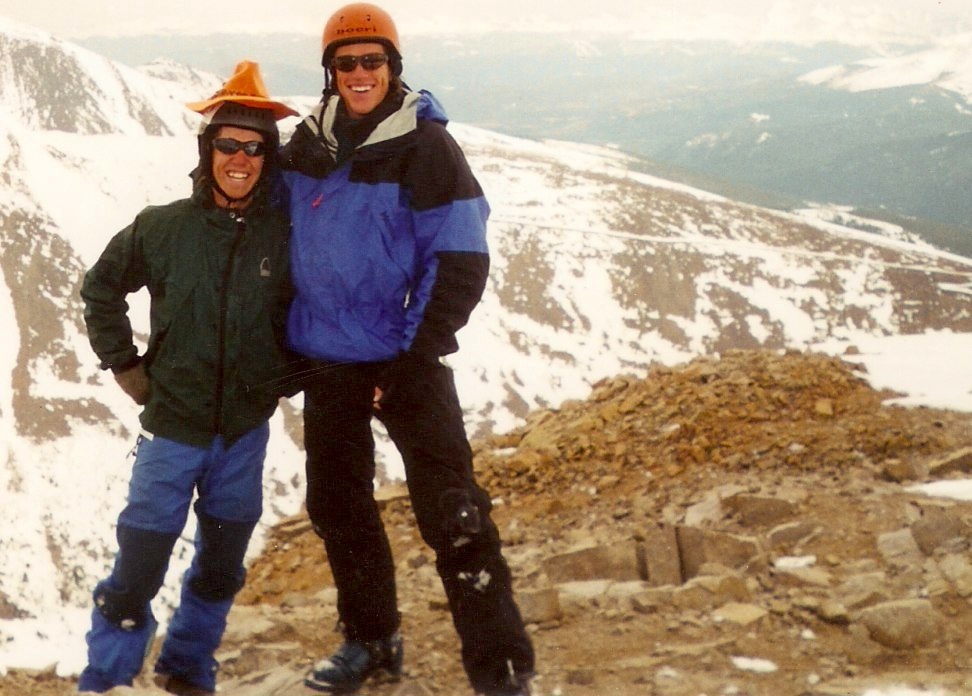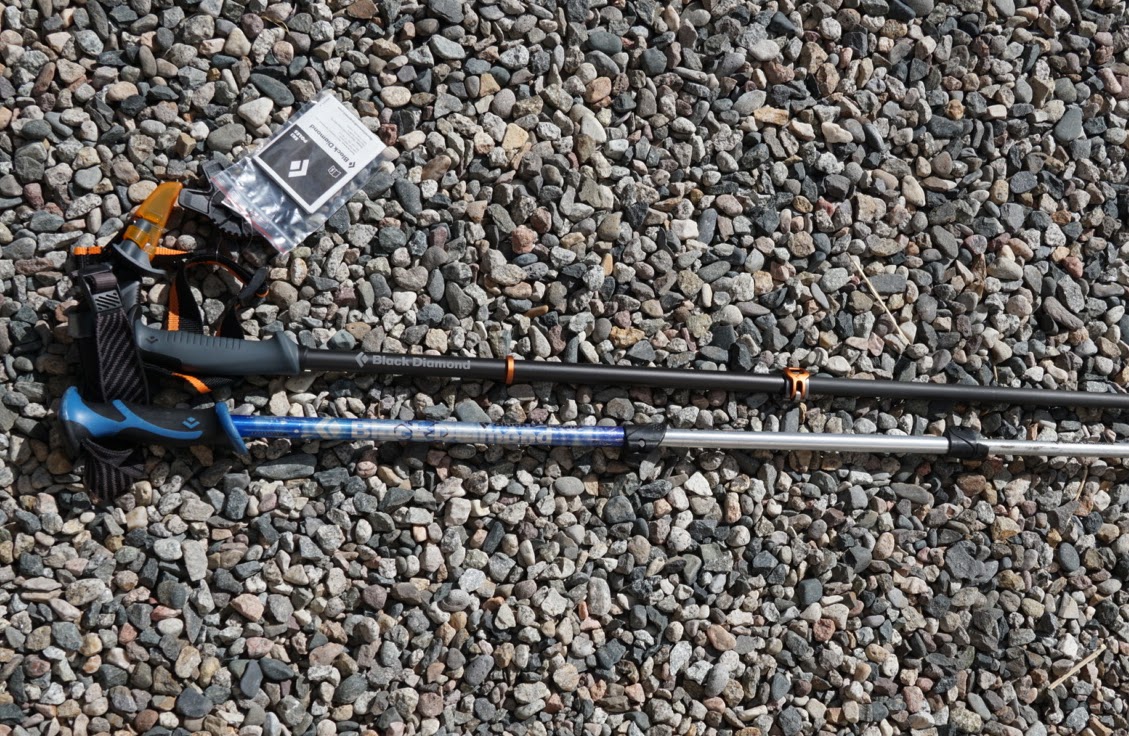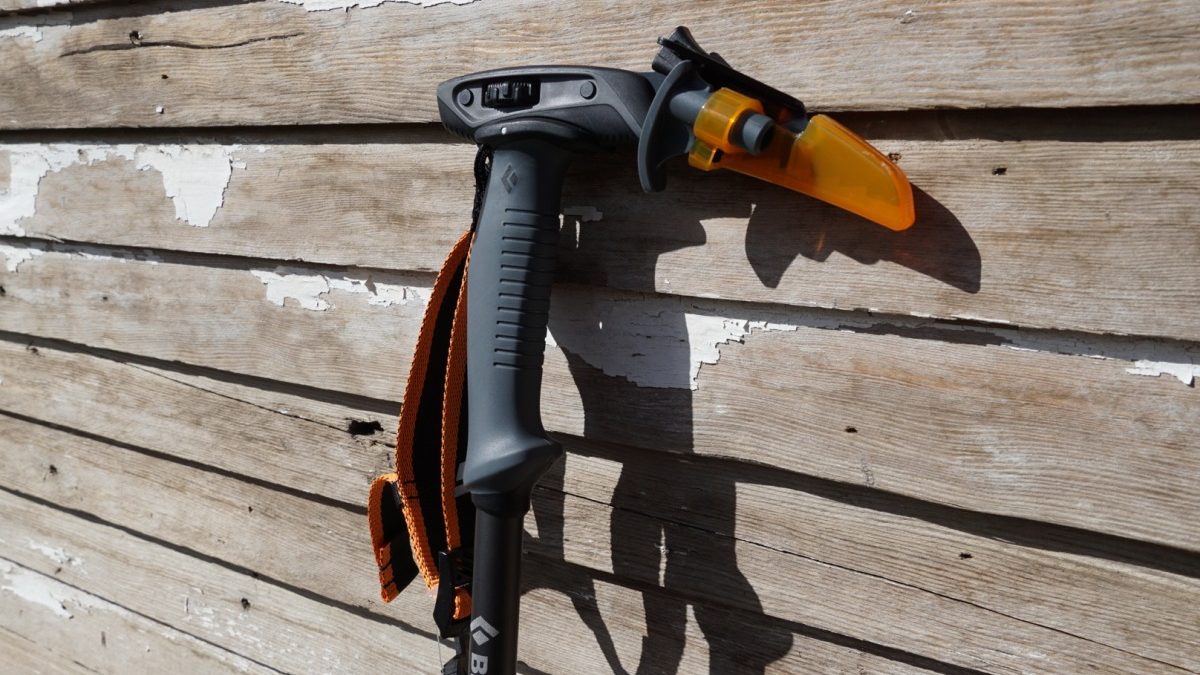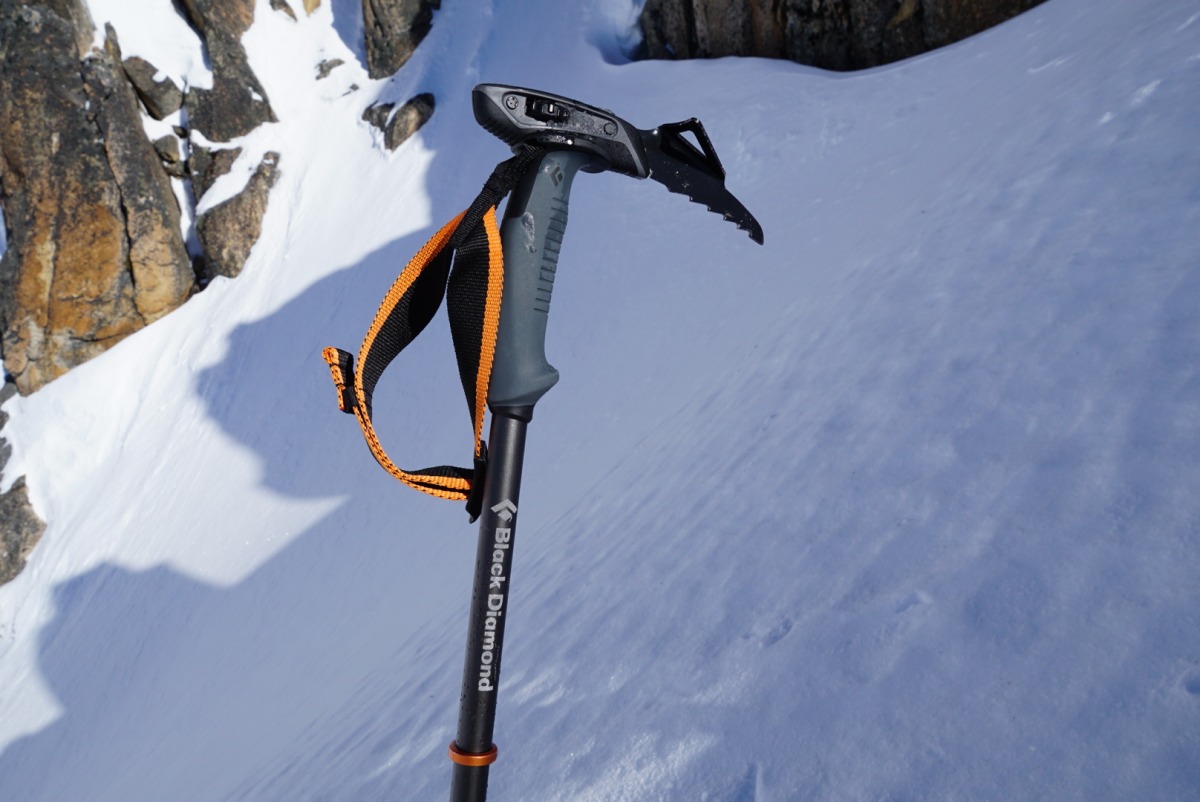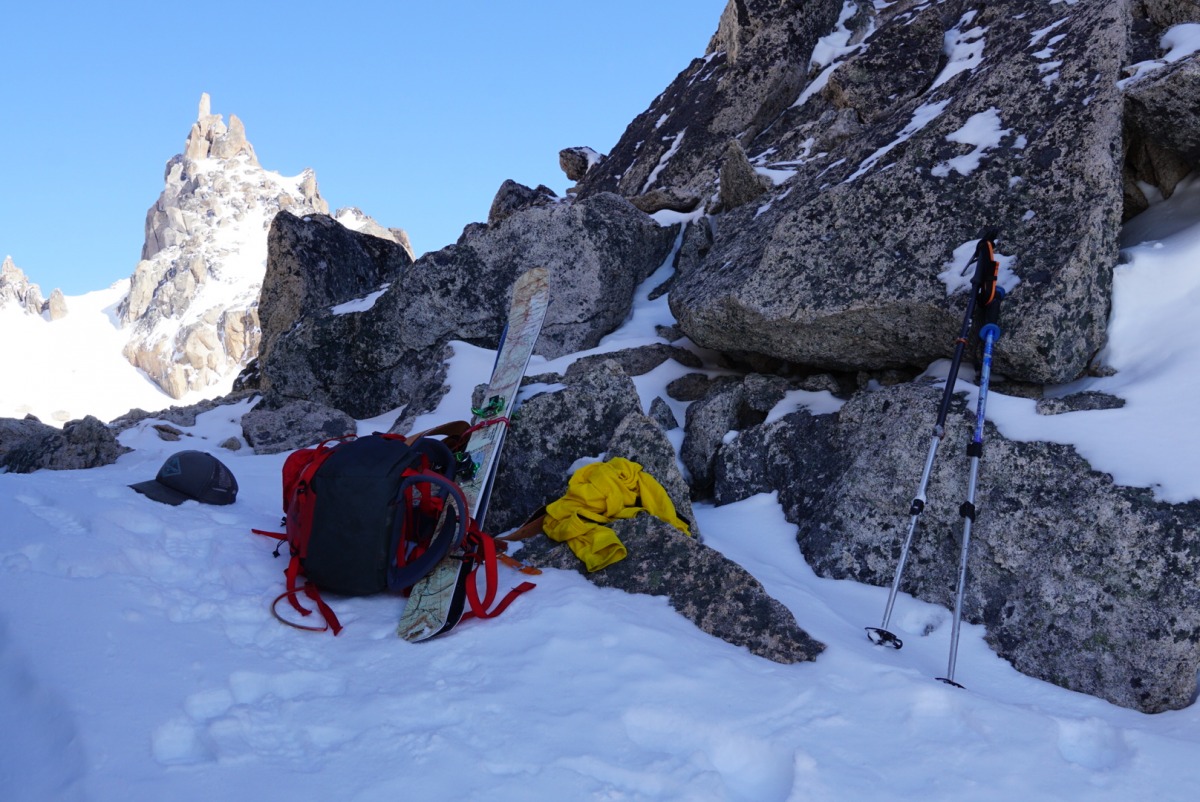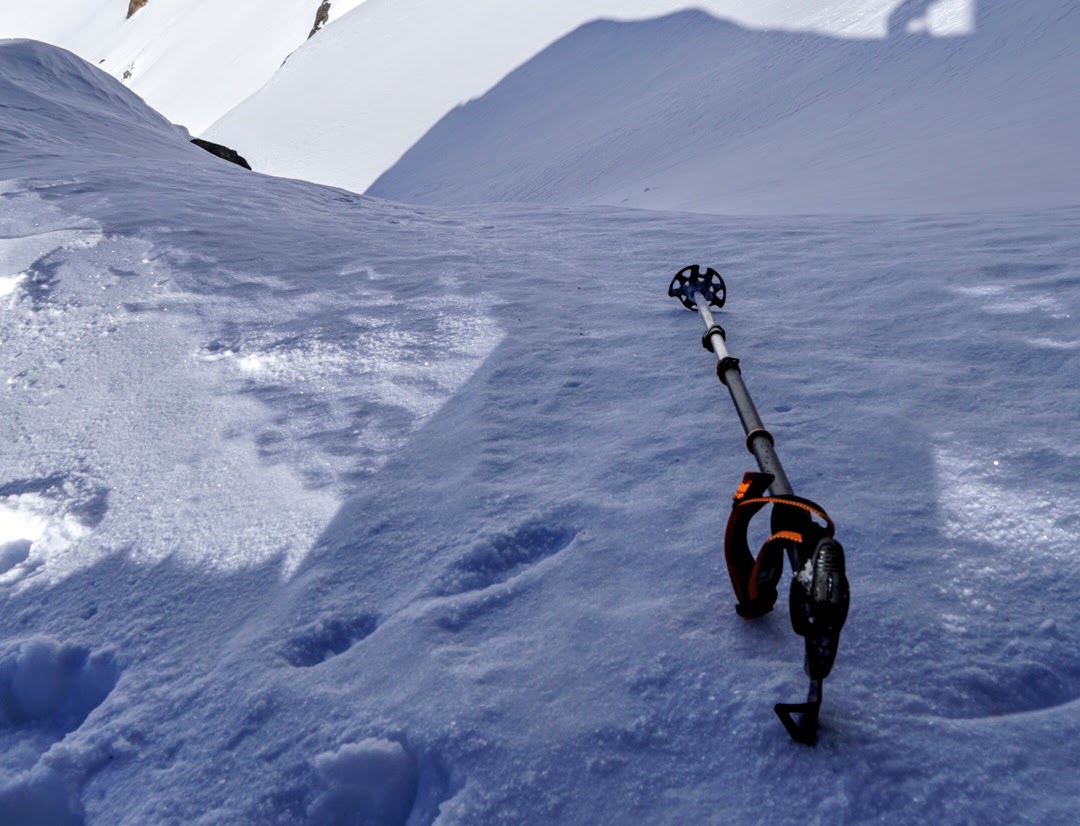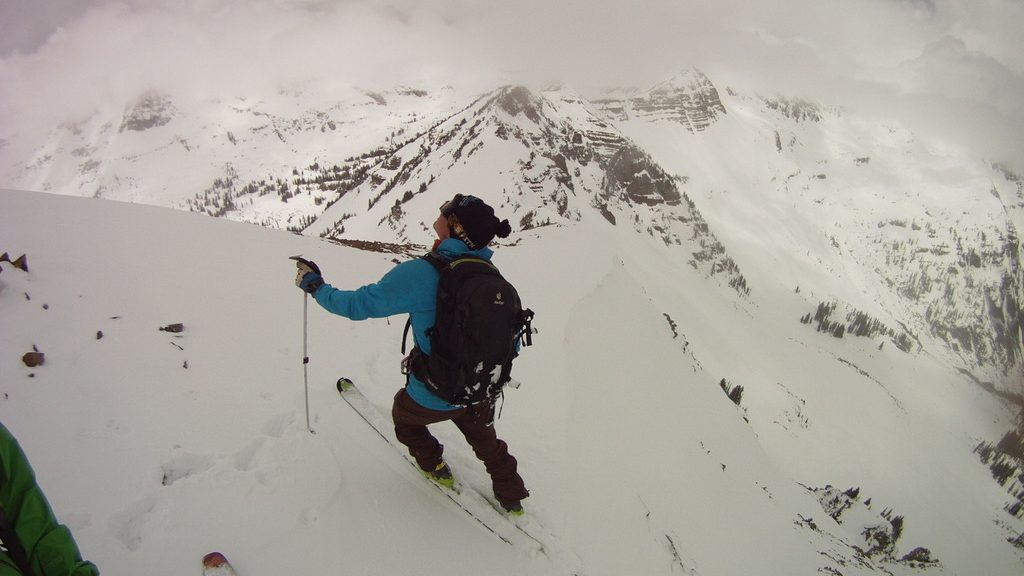
A classic spring scene: Chris Miller waiting for the clouds to break deep in the Elk Mountains. Whippet in hand. Not pictured: Chris’s other Whippet. He carries two.
When I was a budding youth trying to get into skiing, I was pretty cheap. I tried to get away with spending as little money as possible to enjoy the backcountry. Sure, this came from a “live simple” philosophy, but it also came from necessity. So, like many skiers out there, I was (and still am to a degree) very skeptical of new flashy tools that claimed to “save your life”. If I had seen Andrew McClean’s brainchild, the Black Diamond Whippet back then, I almost certainly would have scoffed at it. Even if I had the money in my pocket, I would have walked away. But then I went spring skiing…
On a cloudy April morning when I was seventeen, I climbed Mt. Lincoln, a fourteener in the central mountains of Colorado with skis on my back. My friend and mentor, A.J., and I waited on the summit for temperatures to warm up a bit so that we could have a classic Colorado corn descent. I was very new to ski mountaineering; rocking leather boots, 3-pin cable bindings, and I-don’t-know-what-gawdawful-skis. We had spent the two prior days practicing transceiver searches, crampon walking, and self arrest techniques. A.J. first showed me how to self arrest with our traditional mountaineering axe, easy enough I thought. Then I asked him “what do I use to self arrest if I fall while skiing?” He went on to teach me how to use my ski pole, or even violently stab my elbow into the snow. “Basically, use anything you can possibly think of that will help you slow down”. Got it. Being the late 90’s, Andrew McLean’s Whippet had not yet hit the mainstream market. Not that it would have helped my overconfident cheap-o teenage self.
In case you can’t see where this is going, the clouds never left that morning and the snow never softened. The wind picked up and a storm seemed to be brewing in the west. We accepted our fate, and began to descend the bullet-proof crust on a 55+ degree slope. I made one solid jump turn which gave me a nice little boost in confidence, so I tried a second turn. That’s when I went from zero to twenty in a matter of seconds. Jutting bedrock littered the slope we had chosen, so “riding it out” was not an option.
As I slid on my side with skis flopping all about, my poles were dangling from my wrists like a string of tin cans on a “just married” car and I couldn’t quite figure out how they would help. I heard A.J. yelling “elbow, elbow!” So I went for it. At top speed, I threw my elbow into the crust and put all my weight on it. First, the crust absolutely shredded my light parka, then my long underwear (that’s what we called base layers in the 90’s). Next, the not-corn snow took my skin. Two good things came from the bloody elbow self arrest: the first is that it worked. The second is that I was still in high school and managed to impress a good many girls with my bold and harrowing mountaineer tale.
I suppose there was a third positive take-away from that experience. I was just lucky enough to learn a huge lesson: a Whippet can save your life. A few years later I saw my first one in a ski shop in Durango. With my dwindling forest fire fighting cash, I purchased it. Retail. Full price. A big deal. With that single purchase I spent more than I had yet spent on my boots and skis combined.
In the early 2000’s, the Whippet looked remarkably similar to what it looks like today: Two pieces, a steel pick with a canard wing, a ¾ diameter basket, and Black Diamond’s FlickLock connection at the upper and lower joint. This design and idea has gone through the last two decades mostly unchanged. It turns out that the original invention pretty much nailed it. Due to my occasional forgetful nature, I’ve lost a few, and have bought new ones throughout the last 20 years. Anyway, it was mostly unchanged until the new Carbon Whippet, which has two big features that set it apart from its past. Hint: one can be found in its name. The other is a welcomed no-brainer.
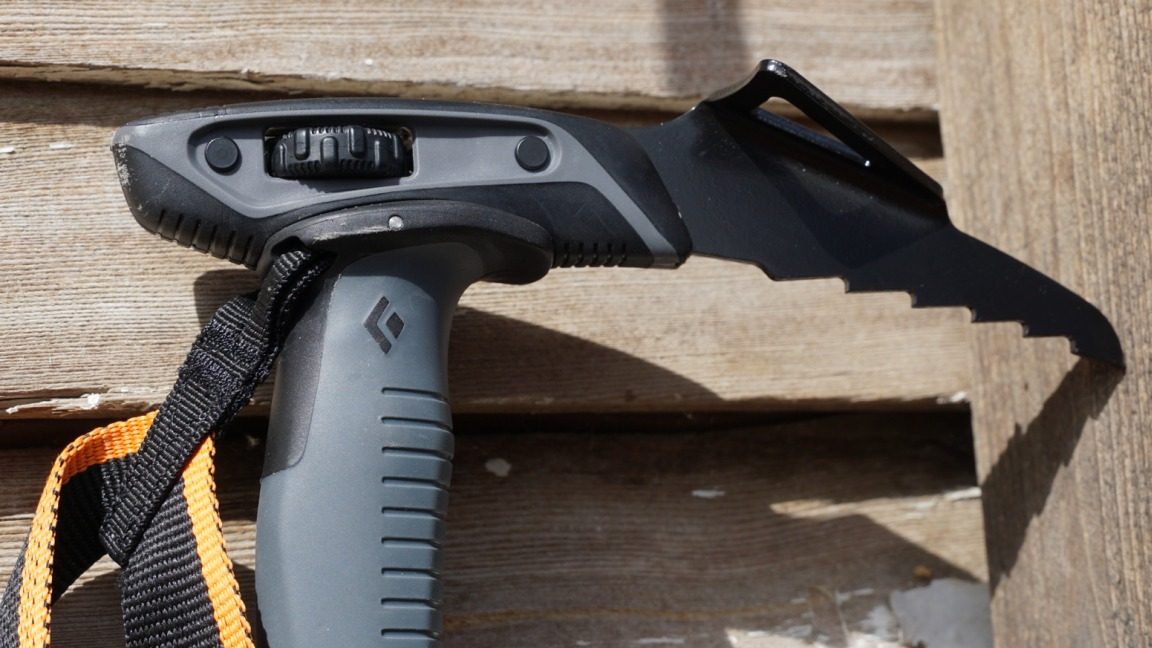
Unsheathed. Note the 1” extension at the wrist strap. This is intended to help the “insert hand upwards from beneath” method.
Last winter, I was able to test out the new Black Diamond Carbon Whippet, which now has the removable steel pick. I brought it with me in October to the Argentine Andes where I was able to put it to the test. After a huge storm shut down our attempt on a few Chilean volcanoes, I rebounded into Refugio Frey for a couple days of phenomenal spring skiing. The hut was nearly empty that week, and I enjoyed a few days of solo skiing in the basins south of Frey, which were littered with couloirs and empty of people.
Before we get to that, though, let’s dissect this tool. The pole with pick weighs in just under a full pound. The pick alone weighs 5.3 oz, 150 grams. Though this is pretty hefty for a pole, I can understand what and why BD did not want to compromise in designing a life-saving tool like this. The FlickLock is the same as on all BD adjustable poles, by now a gold standard for pole connection. One nice little addition is the aluminum collar-like ring found about eight inches down the shaft. This ring is intended to be a grip support when climbing steeper slopes. I have always used some sort of grip support in this spot on my poles. I have a trusty pair G3 poles which have a similar ring made from soft plastic, and any other pole I’ve used has a stout ring of duct tape in that place.
Out of the box, the Carbon Whippet comes with a pick protector, attached with an elastic lanyard. Though I happily ski and travel without this protector, one cannot argue that it’s a good idea, and it eases safety concerns about carrying sharp picks.
But the real excitement is the removable pick. Is this just a gimmick to make us want to buy the new flashy thing? As I packed my ski bag bound for Buenos Aires, I employed this handy feature immediately by removing the pick and wrapping it in cardboard. I then put the pick in my other checked bag, which gave me peace of mind that maybe customs agents would be less likely to open and mess with my ski bag. The removable pick comes with a little plug that goes in the hole that is left by the pick when removed from the top of the grip. Good idea, though I fear I’ll lose it within a year.
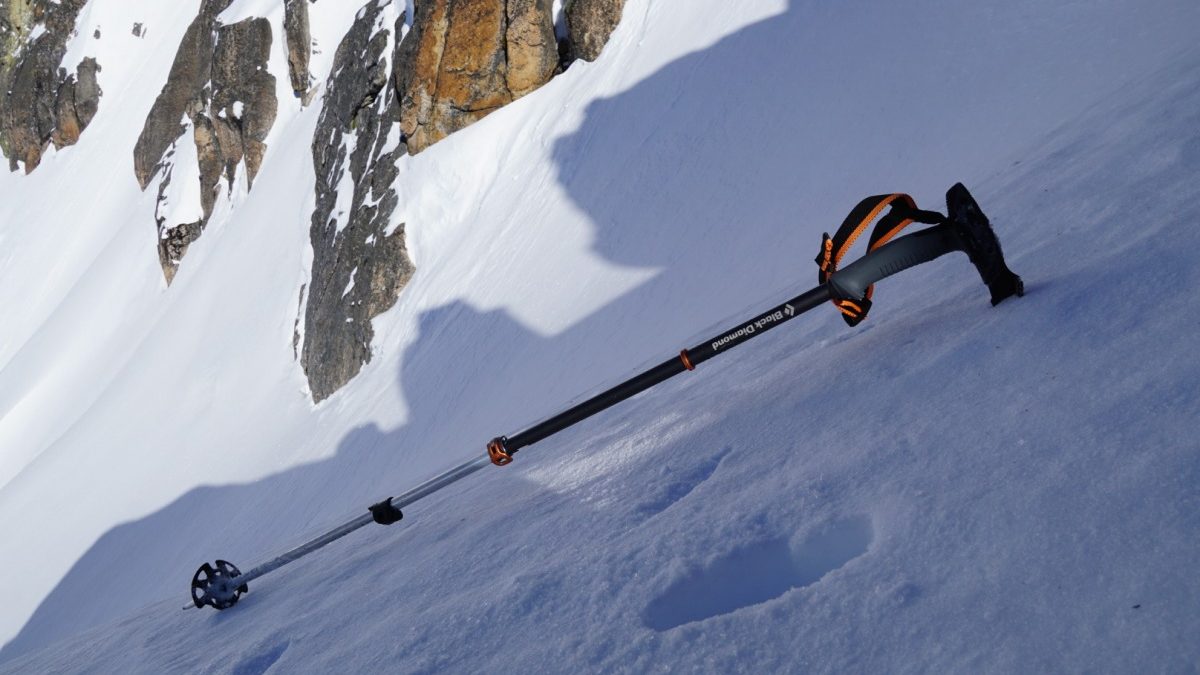
One function I’ve found myself using with the Whippet is at transition points, I stab the pick into the snow just like this picture, and will use it as a tie-off. Buckle your helmet to it, clip gloves. A nice piece of mind when a simple mistake means a piece of gear could take off like a rocket.
Back at Refugio Frey, I put the Whippet to use immediately. Does this mean I immediately stepped on to slippery slopes and began to fall all over the basin? Nope. We often talk about the whippet as a self arrest tool. But the tool’s real utility is in climbing, traversing, and transitioning on steep, slippery faces. In other words, it helps prevent us from getting into a self arrest situation. Black Diamond states on their website that this product will give you “extra traction on steep, high consequence terrain.” I’d like to add that it gives you traction on steep low consequence terrain as well. Nobody wants to slip down a slope unintentionally, no matter how benign the terrain. And this is where the Whippet shines by adding just the right boost of confidence. As for the removable pick, I never removed it on that trip. As I skied up and down the firm spring snow that week, the pick was my best friend.
On my last night in the refugio, the hut-keeper, Pana, and I were chatting. He asked me about my shiny new ski pole. I explained that I had to test it and write a review for Wild Snow. Without hesitation, Pana grabbed it from the table, lifted the ice pick up to hang on a ceiling beam, and proceeded to do about twelve pull-ups with it. With a laugh, he returned it to the table and said “I guess it is pretty strong”. Indeed Pana, indeed.
For specs, weight, mods, and all things we gear geeks at WildSnow have come to love so much, Lou’s write-up on the Carbon Whippet is a must read.
The concept of the Whippet, to me, does not need testing or defending anymore. There are piles of testimonies out there in which a Whippet saved someone’s life. Though there will always be a skeptic wondering if it’s dangerous (it might stab me), most of us can agree that when we weigh all the risks and rewards, we no longer scoff. We bring the Whippet.
Shop for the BD Carbon Whippet with removable pick.
Andy is the founder and owner of Beacon Guidebooks, a ski guide and mapping publisher. Author of Backcountry Skiing: Crested Butte Colorado, Andy has been skiing Colorado’s backcountry his entire life. Raised on cross-country skis pulled from a dumpster in Fort Collins, he started his ski career following his parent’s tracks along Cameron Pass. He moved to the Colorado’s western slope in 2000 and now resides with his wife and son in Gunnison. From woodworking to book writing, Andy is a craftsman to the core. He believes that sharing relevant information and photos about skiing the backcountry will help travelers spread out, get inspired to explore, and most importantly, make better and safer decisions.

